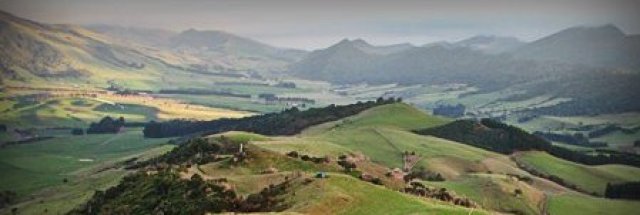I have stood on hilltops in the south and felt the bone-biting blast of Antarctic winds. I have felt the difference between that and the relief you get when you shift to a space three to four tree heights out from a shelterbelt, or mid way down the sunny lee slope. I’ve felt the climate shift from winter to spring in 150 metres.

I’ve watched stock move in the morning from their night camp on the northeast of the ridge, sheltered from the winds, then work the gentler tops and spurs before heading down the face for the valley, and then back up to the ridge with the waning of the day to escape the coming frost and catch the early sun. The face a route, not a place to be until the feed grows short on the best places. I’ve worked with stock GPS collars and mapped the patterns on a page. I’ve watched stock seek out shelter and shade at times, and not in others, and lamb in the dumbest places. I’ve watched some respond by planting trees, and others who prefer “the good clean farm.”
I’ve looked at how the height, form and species of trees in a natural woodland shift with topography and edge. I’ve seen pines grow only to the height of the dunes,

buds sheared by salt-laden gales, ancient and sculpted to the land. I’ve seen them in the depth of dissected gullies reach for the sky.
I’ve seen cattle bogged in a wetland; desperate rescue efforts with a tractor and a chain.
I’ve been woken from a deep sleep by a big slip on a back face that should never have been in grass. The land growls. I’ve been woken by the sound of a grandmother Rimu falling on a calm night – just its time to die.
I’ve seen gorse cleared in gully systems for yet more grass, and the stock travel there once for every five times they
 feed on the ridges and valleys. I’ve seen the gorse come back, and seen the helicopters fly to douse it again with chemicals to clear it once more – because there is a god called grass … and then again …
feed on the ridges and valleys. I’ve seen the gorse come back, and seen the helicopters fly to douse it again with chemicals to clear it once more – because there is a god called grass … and then again …
…. because you get no wisdom in the classroom, only the capacity – or not – to learn lessons for yourself. Lessons that sink into your soul come from your observation, not from taught commands, and if you do not observe the patterns and music of the real world outside the theories, you do not learn. I’ve seen those educators who open the capacity of minds and souls to see and think and be, and those that close them.
I’ve seen creek banks falling, and streams in flood snaking like a garden hose on the lawn, cutting and gouging a wadi out of the bottom lands – scouring away all that is good. I’ve seen streams filling with soil like an arterial spurt from the land. Blood you won’t get back in your lifetime or those of your kids.

Shifting conditions in time and space. The patch dynamics of ecology.
Interrelationships. Patterns. Linkages. Multiple function and polycultural forms. Uncertainty and combinations of indeterminism and chance.
Variations and patterns in production of pasture. Variations in woodlands and trees. Variations in how animal and vegetable combine, in how water meets and moves. Variations in the species mix, where the ‘weeds’ appear and where the ryegrass hold in, and doesn’t. Patterns of birth and death. Variations in the costs of care. You don’t just see these patterns, you feel them. And you can music when you feel.
Flux! Though we’re not always taught about the  dominance of that integral experience of flux; the dominance of diverse pattern and interrelation creating something new with each step and breath; the difference in the combinations of things and which one drives the system – on this day, in this hour, in this patch.
dominance of that integral experience of flux; the dominance of diverse pattern and interrelation creating something new with each step and breath; the difference in the combinations of things and which one drives the system – on this day, in this hour, in this patch.
Discordant Harmonies. One of those books that makes you go “Yes! This is what I see.”
We’re told to presume in most cases a regularity, all the better to formulate, to predict, to regulate, to measure, to control, to command. A presumed regularity in all things, which – like Dark Matter – isn’t necessarily there.
We’re told to prefer the one function, and make it one form. We’re told to push the complexity into something that suits the less patterned monochromatic view of life …. as a machine.
Chris Perley
Thoughtscapes
Chris Perley has a field experience, management, policy, consulting and research background in land use, rural economies, environments and communities, and is an affiliated researcher at Otago University’s Centre for Sustainability.